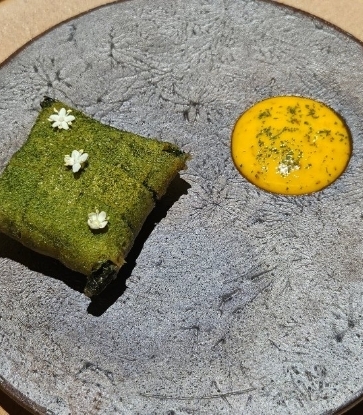Lamiat might be a Thai word, but the concept of ‘attention to detail’ applies worldwide. This is particularly true in the culinary world, as the philosophy behind many of the world’s great kitchens involves attention to every single detail, a dedication to craftsmanship, respect for the food and the team, and harmonising the processes and products. The French kitchen at J’aime by Jean-Michel Lorain also embraces the Lamiat philosophy in its various ways of working.
Chef Amerigo Sesti is the head chef, representing the highly-respected chef Jean-Michel Lorain at this Bangkok outpost. Through learning about the cuisine, working with the master and leading the kitchen to earn a Michelin star in the city’s inaugural guide, the protégé of Chef Lorain reveals how Lamiat features in the the restaurant’s success.

To fully understand the work and the cuisine at J’aime, Chef Sesti says, it’s necessary to go back to Chef Lorain’s original restaurant, La Côte Saint Jacques in Burgundy, France. It was opened in 1945 by his grandmother, Marie Lorain, who started off by cooking in the classical French way. Her son, Michel Lorain, took over about a decade later, and earned the first Michelin star for the place in 1971. Jean-Michel Lorain joined his father in 1983, and was the youngest chef to receive three Michelin stars in 1986 at the age of 27. With their unique influences, all three generations have helped to make ‘Lorain cuisine’ what it is today, so the restaurant keeps its classic roots but adds the freshness of modern touches. “It's really like watching the evolution of French cuisine over the last 60 years, what is represented in J’aime.” And it’s still evolving. “Right now they’re producing a different product compared to when he was 24 years old and started working with his father. Everyone brings new creativity and techniques into the restaurant.”
“What I sense in Chef Lorain’s kitchen is a long history and a deep respect for products.” Offering different products is one thing that distinguishes the cuisine at J’aime from other restaurants; an example is black garlic, which is featured on the menu. “There’s a certain attachment to the original territory of Burgundy, but this is blended with a vision to use unusual ingredients that he brings in and works with, adding flavours and techniques he knows.” Lamiat is identified here as the hard work necessary to understand different ingredients and their potential to make a dish work, while not changing it into local cuisine. “Chef Lorain’s food is not fusion,” Chef Sesti insists. “It’s just that we’re located in Bangkok, so we use local ingredients and blend them into modern French cuisine.”
This deep respect for ingredients seems very simple, but it takes a Lamiat eye to see. “What I admire about Mr. Lorain’s approach is his emphasis on taste. He pays close attention to flavours and respects the product. Ultimately, everything on a plate is there for the taste, not just for show. And I really like that.”
In our view, there must be a mutual respect between Lorain and Sesti to make this cuisine work in such a different location, although the Bangkok head chef humbly says, “I’m very honoured to represent Lorain’s history and bring it to Bangkok.” And clearly Chef Lorain entrusts Sesti to represent him well.
“Although I am here to represent him, he allows me space to express myself and gives me the freedom to reinterpret the dishes.” There’s an unmistakable tone of admiration and thankfulness in his voice. “I think that’s something hard to find in a chef. Normally we have a personal vision and we don’t want to change it.”
As foodies throughout the world would agree, all good food has personality. Working under a chef’s name means there are some guidelines involved. Here, as Chef Sesti says, it is more about how the chef approaches products. But when it comes to real-life exposure to the ingredients, different palates and different cultures in a new city, there are so many complex decisions to make.
Recipes are sent over from France. Some go directly onto the menu without any changes, like the signature Mille-feuille “Napoleon”, characterised by three kinds of cream, almond slices on each side and powdered sugar on top, while other signature dishes are slightly modified. For example, ‘razor clams in their gelée with savoy cabbage and sea urchin cream’ didn’t originally have the clean look of all elements on the shell—this is the reworking of Chef Sesti. The input of modern techniques and non-French ingredients does not affect the Lamiat craftsmanship that French cuisine is known for.

Chef Sesti also loves to create new dishes, using guidelines and feedback from his master, and then continuing to develop them. He likes to come up with flavour combinations that offer a new experience for diners. One example is a current item on the menu ‘Duck foie gras torchon, marbled with bonito and wakame seaweed, served with a mushroom chutney, plankton salt and miso bread’. In 2015, they offered a foie gras dish with miso soup. “We had it on the menu a few years ago and I thought we could do something with the foie gras-miso pairing,” says Sesti. Two of the most delicate cuisines in the world—Japanese and French—show how Lamiat is needed to deeply understand and recreate an idea. Now, there’s a new version of beautifully-marbled foie gras torchon, seasoned with miso, bonito and wakame seaweed. “This is an example of using a very French item like foie gras, but giving it a new perspective for both Asian and European palates. We try to create something unexpected.”

Meanwhile, ‘pan-seared Kamui beef fillet served with carrot and apple purée and rosemary jus’ uses the more common French combination of beef with carrots. Different preparations of carrots compliment the Japanese beef, while the tartness of the apple lends a zesty flavour that balances the richness and fattiness of the dish. It comes down to Lamiat in the harmony of flavours. “In his cuisine, Chef Lorain always aims to find a balance between the components and flavours that finally gives the results that the guests expect.”
Going back to his culinary roots, Chef Sesti sums up his view of working with French cuisine. “What I recognise about French cuisine that’s uncommon with other cuisines is the fact that it firstly defines what is standard practice, and then elaborates, refines and constantly searches for improvement. Thus French cuisine translates easily into fine dining. It gives a chef the freedom of ingredients and techniques to play with, leaving space for evolution.” His summary reflects the philosophy of Lamiat— a deep respect for the tradition and craftsmanship that go into the production of Chang Lamiat, resulting in harmonious and refreshing flavours; a product that has evolved and will continue to evolve.
This content was brought to you by Chang, Official Partner of the MICHELIN Guide 2018.
www.changbeer.com
www.facebook.com/changbeer/
Here's what our inspectors said about J'AIME by Jean-Michel Lorain (1 Michelin star)
Enter this hotel restaurant and your world gets a little topsy-turvy, with a grand piano hanging from the ceiling and upside down chandeliers. But one bite of the creative French cuisine and all will be right again. Choose from one of the five, seven, or ten-course tasting menus to get the full experience. The restaurant and menu were conceived by renowned chef Jean-Michel Lorain - his daughter adds charm and one of his protégés runs the kitchen.






















